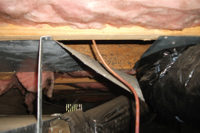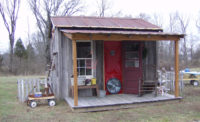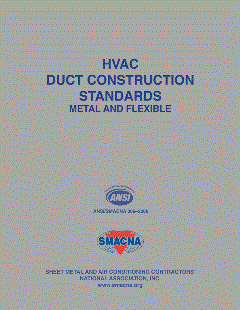
|
| The building side of the duct system, including the quality of the insulation, directly impacts customer comfort. |
A primary goal of an HVAC professional is to ensure a customer’s comfort. Let’s say you have designed and installed an HVAC system that is absolutely perfect. The equipment is operating right on the manufacturer’s specifications and sized properly according to load calculations and equipment selection procedures.
Your duct system is installed correctly, free of duct leakage, insulated with the highest R-value insulation you can buy, and is delivering the proper amounts of airflow to each room. Sounds like a great HVAC system, doesn’t it? There’s only one problem: The customer is complaining he isn’t comfortable.
One of the primary measurements customers use to gauge comfort is the room temperature shown on the thermostat display. If the number falls within an acceptable temperature range, the individual should be comfortable, right? Not quite. Could there be other factors at play here that are influencing their comfort that you might be missing?
Air Temperature Limitations
One of the main measurements used to verify proper Btu delivery of an HVAC system is air temperature. When two air temperatures are compared to each other, it is called delta t (Δt). If the delta t is within acceptable limits and combined with proper airflow, you can be pretty sure the traditional side of the HVAC system is operating correctly.
One issue not considered here is the influence the building side of the duct system is having on your customer’s comfort. When everything looks right with the traditional side of the HVAC system, it’s time to focus your attention elsewhere.
The Building Side of the Duct System Tie-in
For the traditional side of the duct system to function properly, you have to control the Btu inside that duct system. This involves controlling the duct system’s temperature and airflow. The building side of the duct system is impacted in the exact same way. If you don’t have control over this side of the duct system, it is hard to ensure the comfort of your customers.
Delta t is a factor here. The building’s surface temperatures and indoor ambient air temperatures are being compared instead of air temperatures from the HVAC system. The larger the delta t between the building’s surface temperatures and indoor ambient air temperatures, the harder it is for you to overcome, regardless how awesome your HVAC installation might be.
Two of the main factors influencing the delta t of the building side of the duct system are air leakage and insulation. Kind of ironic as these are also two of the main factors influencing the delta t of the traditional side of the duct system.
Air Leakage Impacts
If you have excessive air leakage through the building side of the duct system, this will greatly increase the delta t. As this delta t increases, so does the level of discomfort your customers experience. When air movement occurs between unconditioned areas of a home and the conditioned areas of a home, heat is transferred.
While heat is being transferred, it is either lowering or raising the temperatures of the building’s surfaces it comes into contact with. It’s important to note this can occur even if proper insulation is installed. If proper sealing of the building hasn’t been done, this air movement will bypass the insulation as if it isn’t even there. Think about this the next time you consider recommending the addition of insulation.
Insulation Impacts
The insulation in the building side of the duct system also has to be installed correctly to control the delta t between the buildings surface temperatures and indoor ambient air temperatures. When the installation of the insulation is of poor quality, or the insulation levels are insufficient, the delta t of the building side of the duct system will increase. Once again, as this delta t increases, so does the customer’s discomfort level, regardless of the thermostat setting.
One area of the building that lacks traditional insulation purposely is any opening that has glass in it. Glass has a tremendous influence on the comfort of your customers. Though you should never find any glass in a traditional duct system, you’ll find glass throughout the building side of the duct system. They have to be dealt with and understood, as they also contribute to the delta t between the buildings surface temperatures and indoor ambient air temperatures. Consider how you felt when you sat next to a window on a cold winter day. You may have caught yourself shivering. Starting to get the connection?
Radiant Heat Transfer
When customers lose their body heat too quickly, they become uncomfortable and start looking for ways to warm up. They often put on additional clothing or turn up the temperature on the thermostat to a point that their bodies aren’t losing heat so rapidly.
On the flip side, when your customers lose their body heat too slowly, they also become uncomfortable and start looking for ways to cool off quickly. This typically means turning on a fan to move air around or turning the temperature down on the thermostat to drop the temperature in the home quickly.
When the air leakage and insulation of the building side of the duct system are not controlled, it has an effect on how customers lose and gain heat. This primarily occurs through radiant heat transfer. With radiant heat transfer, your body gains heat from any surface it is warmer than, and loses heat to any surface it is cooler than.
For ideal comfort conditions to exist, the surfaces of the building side of the duct system should be very close to the temperature set on the thermostat. If the surface temperatures and air temperatures are close, delta t is minimized and comfortable conditions can exist for customers. If the surface temperatures of the building begin to vary from the temperature of the air, the level of radiant heat transfer becomes too fast or too slow. When this occurs, it becomes harder for you to maintain occupant comfort.
One measurement used to quantify this interaction is mean radiant temperature. Mean radiant temperature is used to measure the effects of surface temperatures on an environment. It is determined with a special thermometer that looks like a black globe. The mean radiant temperature is then used to adjust the ambient air temperature to account for the influence of the building surfaces.
Thermal imaging cameras are also a valuable test instrument that can help you identify surface temperature issues. When used properly, they will be one of your most valuable test instruments for uncovering and solving issues associated with surface temperatures. Using a blower door in conjunction with a thermal imaging camera is a great way to see the impact of air leakage and surface temperatures together.
Controlling the Building Influence
The building side of the duct system has a direct influence on the comfort of customers. In order to properly condition the indoor environment, you have to understand it first. For example, a floor temperature of 63°F will have a huge negative impact on overall occupant comfort when compared to a much more comfortable 73° floor temperature.
For comfort to be maintained, you have to maintain the conditions inside the building side of the duct system that allows bodies to lose heat at a speed that keeps occupants from either freezing or burning up. Unless you address both sides of the duct system, you’ll miss opportunities to truly solve these problems.
Publication date: 11/10/2014
Want more HVAC industry news and information? Join The NEWS on Facebook, Twitter, and LinkedIn today!











